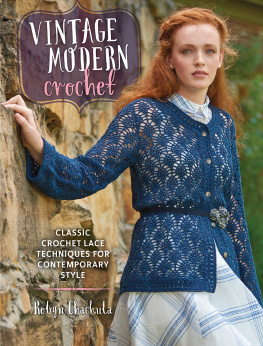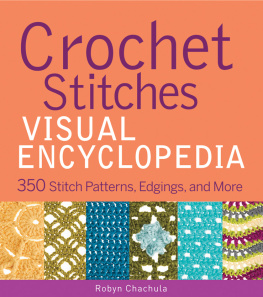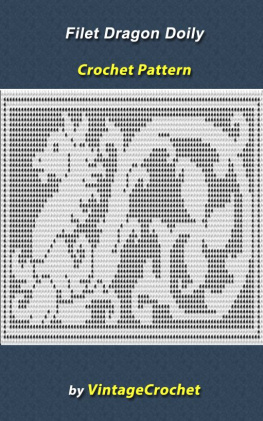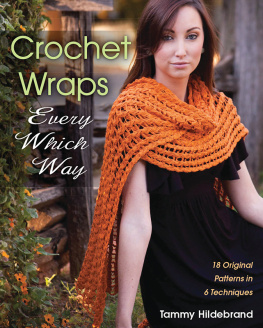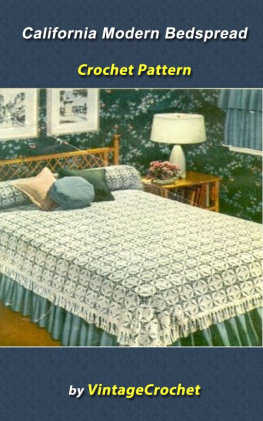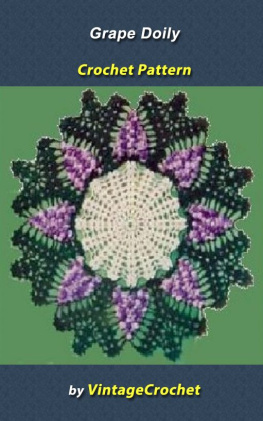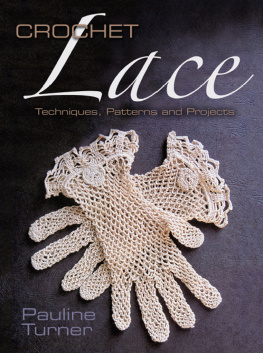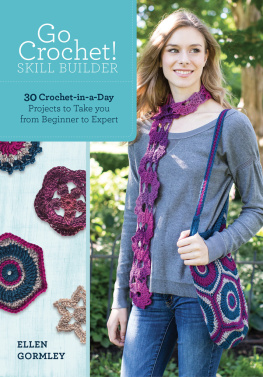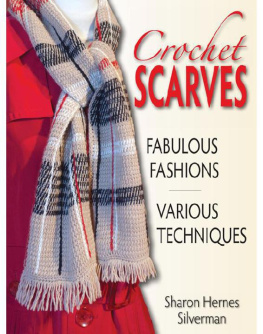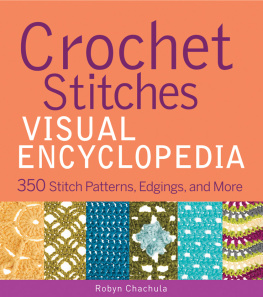Contents
Guide
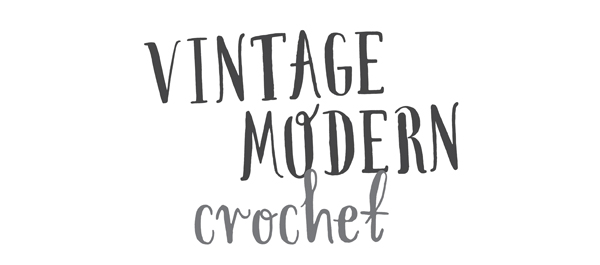
CLASSIC CROCHET LACE TECHNIQUES FOR CONTEMPORARY STYLE
Robyn Chachula

Dedication
This book is dedicated to all my crochet students for keeping me inspired and excited, so I can come up with fresh and new designs.
CONTENTS
INTRODUCTION
Marrying vintage techniques with a modern sensibility has been a mission of mine for years. Crochet has a long history of exquisite patterns and motifs that are sparingly published, because they harken back to items that we deem dated. For me, I love all the doilies and tablecloths that might have been found in my grandmothers house. Sometimes I wish I could just toss a tablecloth on as a shawl to display all of its complex stitches. (Okay, so I have totally done that in real life more than once.)
Crochet is such a vibrant art form that the right design and designer can breathe new life into these techniques and reinvent them in beautiful, compelling ways. That is what brought this whole book about: the pure love of all crochet lace techniques and the desire to be able to wear those creations and look fabulous without looking dated.
Its my pleasure to showcase all of these lovely stitches in one book. I am proud to be joined by like-minded designers who also have that vision. Their designs are so amazing that I really wanted to grab some yarn and a hook to start many of them for myself.
You will notice that all the projects are fashion-forward and styled for today. This is done to help you, too. When you make that amazing top or scarf for your sister, niece, or granddaughter, you can show her how stylish it is. It will be our secret that you are using the very same techniques women from the 1850s used while crocheting for their loved ones. That connection to history is important, not just to me but to all of us in keeping our art form vibrant and alive by honoring techniques that our ancestors used. The only difference between our crochet and our ancestors crochet is our modern yarn and thread. I know my grandmother crocheted with very vibrant colors for everything, but she had to dye it herself. We are lucky we dont have to invent our materials (unless we really want to), but instead we can focus on the great creations that come about.
The techniques we use throughout the book are only the tip of the iceberg of antique techniques. We will look at the modern retelling of Pineapple Lace, Bruges Crochet, Irish Crochet, Filet, and Tunisian Lace. All of our stitches are classics; only the way we are presenting them is modern. I cant tell you how much I enjoyed designing the pieces that use these fantastic techniques while making projects that could range from timeless cardigans to trendy accessories. I hope we inspire you to keep crocheting and to fall in love with all these impressive techniques.
I hope you truly have a wonderful time crocheting these beauties, and I cant wait to see your twist on our designs.
Robyn Chachula
CHAPTER 1
PINEAPPLE LACE
In Colonial America,the height of status and wealth was to have a pineapple on your table; it showed good taste and lavish wealth. It also demonstrated the impressive capabilities of the hostess to procure one (even if it was rented for the occasion!). Pineapples were so rare that King Charles II of England was painted in portrait, depicting him being given the golden fruit.
It only makes sense that the pineapple subsequently became a symbol of hospitality. With such a potent meaning attached to its image, the pineapple materialized in all crafts and handiwork, from tapestries to needlework, printings, and of course, crochet lace. Some of us romantically think back on our grandmothers tables, with their pineapple lace doily and tablecloths; or fondly recall their elegant clothes with lace collars and trims. There never has been a time when pineapples werent beloved. In the 1930s, they dominated fashion and needlework magazines. This makes sense, since during the Great Depression women were looking for inexpensive ways to brighten and refresh their wardrobe. All that you need for a lace collar is some thread, a hook, and know-how.
Even now, when doilies have lost favor and you rarely see a collar with tons of lace, we still love pineapple lace. We love it for its exquisite beauty and complex-looking patterns. Sure, we may not use it for the centerpiece of our table, but we would be thrilled to have a pineapple lace tunic, oversized cardigan, lightweight shawl, or silky cowl to wear.
The hidden beauty of pineapple lace is that even though the patterns are usually extremely long, they use classic stitches and are quite easy to "read" on the fabric. The projects in this book are stunning to start with and need a bit of concentration to follow. But the results are amazing.
If you have never picked up a pineapple lace crochet pattern before, I recommend the Bromelia Infinity Cowl. It is rectangular in shape, so you dont have to worry about any shaping along the way. If you are looking for the perfect present, you might want to try the OHara Hat. It is the perfect slouchy hat for cool days. Zoe Cardigan is the project that you can make now and wear for years. It is the classic lace cardigan that never goes out of style. The Kidwell Garden Wrap is a project that uses pineapple crochet in new ways, rotating how we see the motifs. No matter what you choose to crochet first, you will have a showstopper in the end.
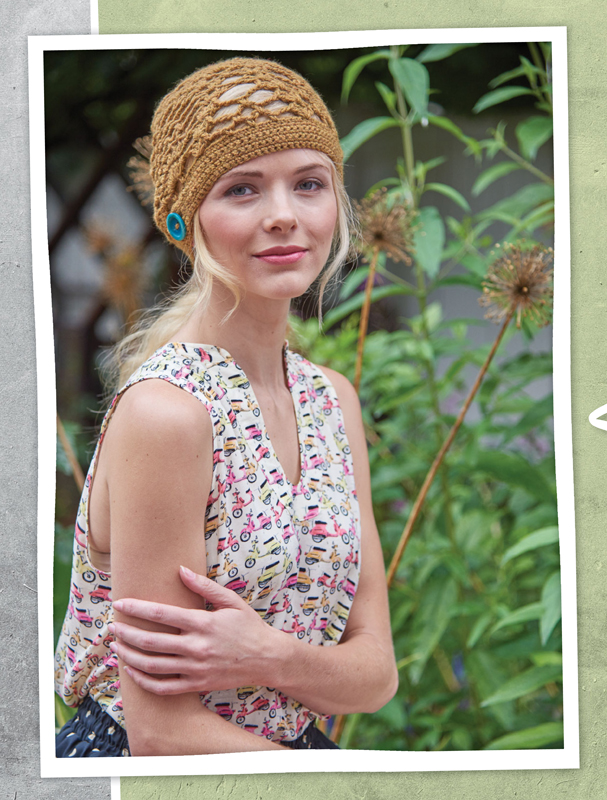
OHara hat
REBECCA VELASQUEZ
Typically, when you think of the pineapple motif, a doily or perhaps even a shawl comes to mind. I knew I wanted to try something a bit different; something fun and modern; something wearable by many women with many different styles. A hat!
FINISHED MEASUREMENTS
Fits average womans head. Hat band circumference = 19" (48.5 cm).
YARN
DK Weight (#4 Medium).
Shown here: Berroco Vintage DK (50% acrylic 40% wool, 10% nylon; 288 yd [263 m]/3.5 oz [100 g]): #2192 Chana Dal, 1 hank.
HOOK
Sizes G-6 (4.25 mm) and H-8 (5.00 mm). Adjust hook size if necessary to obtain the correct gauge.
NOTIONS
Locking stitch markers; tapestry needle for assembly and weaving in ends; one 1" (2.5 cm) button.
GAUGE
16 sc by 20 rows= 4" 4" (10 10 cm) with size G-6/4.25mm hook.
NOTE
The hat is worked from the bottom of the crown portion to the top, then the hat is turned and the band is added by stitching into the bottom loops of the foundation chain.
STITCH GUIDE
Shell (sh): (2 dc, ch 1, 2 dc) in indicated st or sp. When a shell is worked into the next shell, all sts are worked into the ch-1 sp of the indicated shell.
HAT
Row 1: (RS) For button on RIGHT side of hat, ch 28, pm in ch just created, ch 60, sc in 2nd ch from hook, pm in sc just made, sc in next ch and in ea across, do not turn87 sc.
For button on LEFT side of hat, ch 60, pm in ch just created, ch 28, sc in 2nd ch from hook, pm in sc just made, sc in next ch and in ea across, do not turn87 sc.

